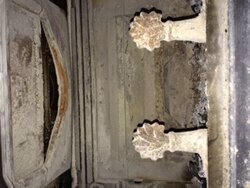My Dutchwest Non-Cat 2478 (bought in 2006) has issues, the most pressing being the severely warped top plate (see attachment - note the smiley faced hole where the damper meets the inner top! It's even cracked slightly at the back corners). Also, I'm pretty sure there isn't much left of the "Fountain assembly", and it needs new "Right End Insulation" and "Right End Refractory".
A quick online search showed:
Inner top: $95
Fountain assembly: $279
Right end insulation: $25
Right end refractory: $79
Shipping $?
I think if nothing else I have to replace the inner top because I can't shut the stove down properly and am going through too much wood. For the right end insulation and refractory, I'm not too worried and am tempted not to spend $100 for those parts.
For the fountain assembly, I'm just not sure... How critical is this part? I don't think it held up much after the first year or two. I assume this helps with the stove's efficient burn, perhaps providing a means for the secondary combustion air to be heated up, slowed down, dispersed etc. Should I spend the $ to replace the fountain assembly, or is it just not worth it? I don't think I've noticed a big difference in the stove when the fountain was fresh and new, and now, but it's hard to tell. I know from hearth.com that others have had trouble with the DW stoves.
So a total of about $500 - I could just buy a new stove. But I'm tempted to just replace the inner top and just forget the rest for now. What should I do? I'm concerned that because of the severe warping I might have a hard time getting the stove apart and fit back together with a new inner top. We're also into wood burning season, so I don't want the stove to be out of commission for long (shame on me for not taking care of this in the summer).
I'm hoping an expert here has had to deal with these issues and can give me some common sense direction. Thanks in advance!
P.S. By the way, I figure the warping must've occurred by leaving the ash door open too long - we sometimes open the ash door to get the stove going from coals in the a.m. especially, and to prevent it smoking up the neighborhood after lighting it. But even after now being careful not to let it get too hot when doing this, the warping seems to have gotten worse. So I suspect that the metal might be partially to blame.
A quick online search showed:
Inner top: $95
Fountain assembly: $279
Right end insulation: $25
Right end refractory: $79
Shipping $?
I think if nothing else I have to replace the inner top because I can't shut the stove down properly and am going through too much wood. For the right end insulation and refractory, I'm not too worried and am tempted not to spend $100 for those parts.
For the fountain assembly, I'm just not sure... How critical is this part? I don't think it held up much after the first year or two. I assume this helps with the stove's efficient burn, perhaps providing a means for the secondary combustion air to be heated up, slowed down, dispersed etc. Should I spend the $ to replace the fountain assembly, or is it just not worth it? I don't think I've noticed a big difference in the stove when the fountain was fresh and new, and now, but it's hard to tell. I know from hearth.com that others have had trouble with the DW stoves.
So a total of about $500 - I could just buy a new stove. But I'm tempted to just replace the inner top and just forget the rest for now. What should I do? I'm concerned that because of the severe warping I might have a hard time getting the stove apart and fit back together with a new inner top. We're also into wood burning season, so I don't want the stove to be out of commission for long (shame on me for not taking care of this in the summer).
I'm hoping an expert here has had to deal with these issues and can give me some common sense direction. Thanks in advance!
P.S. By the way, I figure the warping must've occurred by leaving the ash door open too long - we sometimes open the ash door to get the stove going from coals in the a.m. especially, and to prevent it smoking up the neighborhood after lighting it. But even after now being careful not to let it get too hot when doing this, the warping seems to have gotten worse. So I suspect that the metal might be partially to blame.


